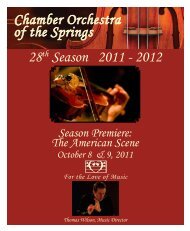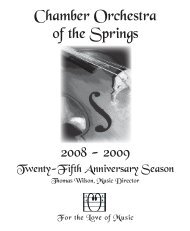Click Here For Concert Program - Chamber Orchestra of the Springs
Click Here For Concert Program - Chamber Orchestra of the Springs
Click Here For Concert Program - Chamber Orchestra of the Springs
Create successful ePaper yourself
Turn your PDF publications into a flip-book with our unique Google optimized e-Paper software.
Wolfgang Amadeus Mozart<br />
Clarinet <strong>Concert</strong>o<br />
in A Major, K. 622<br />
Overview: Wolfgang Amadeus Mozart<br />
Born: January 27, 1756, in Salzburg<br />
Died: December 5, 1791, in Vienna<br />
Work Composed: September 28 – November 15,<br />
1791<br />
Why It Matters: Finished less than a month before<br />
he died, this is Mozart’s last concerto. The lyricism,<br />
grace, and extended structure <strong>of</strong><br />
<strong>the</strong> piece set a new standard for<br />
wind and brass concerti.<br />
I declare to you before God, and<br />
as an honest man, that your son<br />
is <strong>the</strong> greatest composer I know,<br />
ei<strong>the</strong>r personally or by name.<br />
–Joseph Haydn, to Leopold Mozart.<br />
The clarinet was still a newcomer to <strong>the</strong><br />
orchestra when Mozart composed his Clarinet<br />
<strong>Concert</strong>o in A Major, K. 622. Mozart added<br />
clarinets to his “Paris” symphony (no. 31) in<br />
1778, but it would be ano<strong>the</strong>r decade and nine<br />
symphonies later before clarinets would play a part<br />
in his G Minor symphony (no. 40), and <strong>the</strong>n only<br />
in an optional role. A clarinet concerto by a major<br />
composer was almost unthinkable were it not for<br />
Anton Stadler, virtuoso clarinetist <strong>of</strong> <strong>the</strong> Viennese<br />
court orchestra since 1787. Mozart and Stadler<br />
met in 1784, when Stadler was a performer in one<br />
<strong>of</strong> Mozart’s wind serenades. Like Mozart, Stadler<br />
joined <strong>the</strong> Freemasons, and <strong>the</strong>y soon became good<br />
friends. Mozart had already composed a concerto<br />
for basset horn (a slightly larger member <strong>of</strong> <strong>the</strong><br />
clarinet family commonly used in church music)<br />
and his Clarinet Quintet, K. 581, for Stadler.<br />
Mozart would rework <strong>the</strong> first movement <strong>of</strong> <strong>the</strong><br />
basset horn concerto for <strong>the</strong> clarinet concerto, <strong>the</strong>n<br />
add two new movements to round out <strong>the</strong> piece.<br />
Completed at <strong>the</strong> absolute height <strong>of</strong> his abilities,<br />
<strong>Program</strong> Notes, continued<br />
17<br />
this is Mozart’s final concerto, especially notable<br />
for its interplay between soloist and orchestra.<br />
About Wolfgang Amadeus Mozart: Mozart<br />
(1756-1791) showed such a prodigious talent<br />
for music in his early childhood that his fa<strong>the</strong>r,<br />
also a composer, dropped all o<strong>the</strong>r ambitions<br />
and devoted himself to educating <strong>the</strong> boy and<br />
exhibiting his accomplishments. Between ages<br />
six and fifteen, Mozart was on tour over half <strong>the</strong><br />
time. By 1762, he was a virtuoso on <strong>the</strong> clavier—<br />
an early keyboard instrument and predecessor <strong>of</strong><br />
<strong>the</strong> piano—and soon became a good organist and<br />
violinist as well. He produced his first minuets at<br />
<strong>the</strong> age <strong>of</strong> six, and his first symphony just before<br />
his ninth birthday, his first oratorio at eleven, and<br />
his first opera at twelve. His final output would<br />
total more than 600 compositions. Much has<br />
already been said and studied in <strong>the</strong> popular media<br />
about Mozart’s roguish lifestyle and apprehension<br />
<strong>of</strong> conformity. It was this aspect <strong>of</strong> his personality<br />
that never won him <strong>the</strong> support <strong>of</strong> royalty or<br />
<strong>the</strong> church, which, at that time, was critical to<br />
any composer’s survival. As such, Mozart died<br />
young, ill, poor, and relatively unappreciated …<br />
only to become <strong>the</strong> mostly widely acknowledged<br />
orchestral composer in history.<br />
The <strong>Chamber</strong> <strong>Orchestra</strong><br />
Volunteer Corps<br />
We wish to thank our volunteeers who assisted<br />
at our opening concert at <strong>the</strong> Cornerstone Arts<br />
Center: Beverly and Denis Pirio, Victoria and<br />
Fred Boswell, Mary Wieger, Jean Tarkowski,Hallie<br />
Cabell, and Mike DeMaree. Also, board members<br />
Susan Loring, Michael Grace, Nicole DeNaray,<br />
and Nasit Ari.<br />
If you are interested in joining our Volunteer<br />
Corps, Please call Helene Knapp 576-1814 or<br />
Pam Marsh 634-6171.<br />
“<strong>For</strong> <strong>the</strong> Love <strong>of</strong> Music”<br />
<strong>Program</strong> notes continue on page 18




